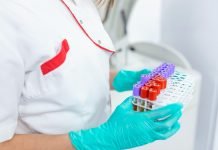
Bridging therapy is a combined therapy of a clot-busting drug and physical clot removal for patients with stroke.
In a new study from University of Illinois Chicago, researchers found that for people who have large vessel occlusion stroke and are treated within four-and-a-half hours after their symptoms start, the bridging therapy generates better results.
And, the treated patients have more chances of surviving and living independently after stroke.
The most common type of stroke is an ischemic stroke, occurring when a vessel supplying blood to the brain is blocked.
When the blockage is in a major artery, it is called a large vessel occlusion stroke.
Large vessel occlusions of the anterior circulation, which were examined in this study, occur in the front of the brain and are a leading cause of adult disability.
Two-step bridging therapy involves the following: intravenous thrombolysis, injecting clot-busting drugs; and mechanical thrombectomy, a minimally invasive procedure in which the blood clot is removed through a small incision.
In the current study, the team examined looked at 41 studies involving 14,885 people with large vessel occlusion strokes with an average age of 70.
Of those, 8,238 people were treated with bridging therapy and 6,647 were treated with clot removal alone. The drug alteplase was used for the clot-busting therapy.
Researchers found that people who had bridging therapy had 29% higher odds of being able to live independently after three months. That would translate into an anticipated additional 62 people out of every 1,000 people who would be able to live independently with bridging therapy versus clot removal alone.
The people receiving bridging therapy also had 24% higher odds of blood flow returning to the parts of their brain affected by stroke compared to people who had clot removal alone, which translated into an anticipated 34 additional people out of every 1,000.
People who had bridging therapy also had 31% lower odds of dying 90 days after their stroke compared to people who had clot removal alone. This would translate to an anticipated 59 fewer deaths per 1,000 people.
As Gabriela Trifan, MD says, while these results are not strong enough to change practice at this time, they constitute a step forward into the concept of individualized medicine, where for selected patients in the appropriate clinical settings, clot removal may be as efficient and safe as bridging therapy.
If you care about stroke, please read studies about brain problem that can increase risk of stroke for up to five years, and findings of common drug that is effective for preventing recurrent heart problems and strokes.
For more information about brain health, please see recent studies about 5 critical steps to help prevent a stroke, and results showing 7 facts women should know to prevent and recognize stroke.
The study was conducted by Gabriela Trifan et al., and published in Neurology.
Copyright © 2022 Knowridge Science Report. All rights reserved.




